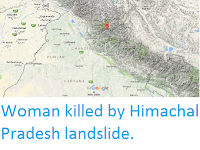An eight-month-old girl has died and seven other people, including two other children, have been injured after a group of tourists was hit by a rockfall in Kangra District in Himachal Pradesh, India, on Saturday 20 July 2019. All of those involved are believed to have come from two families from Haroli in Una District, also Himachal Pradesh, who were walking on a trail between Bhagsu Nag Temple and the Bhagsu Nag Waterfall at the time of the incident. The landslide is the latest in a series of events connected to heavy rains in the area, brought on by the onset of the Indian Summer Monsoon. Mountainous areas of Himachal Pradesh (which is
most of the state) are notoriously prone to landslips and rockfalls, particularly
during the monsoon season, which lasts from July to September, when very
high rainfall levels can trigger many such events. Landslides are a common problem after severe weather, as excess
pore water pressure can overcome cohesion in soil and sediments,
allowing them to flow like liquids. Approximately 90% of all landslides
are caused by heavy rainfall.
The scene of the 20 July 2019 Bhagsu Nag rockfall. Kamaljeet/The Tribune.
Monsoons
are tropical sea breezes triggered by heating of the land during the
warmer part of the year (summer). Both the land and sea are warmed by
the Sun, but the land has a lower ability to absorb heat, radiating it
back so that the air above landmasses becomes significantly warmer than
that over the sea, causing the air above the land to rise and drawing in
water from over the sea; since this has also been warmed it carries a
high evaporated water content, and brings with it heavy rainfall. In the
tropical dry season the situation is reversed, as the air over the land
cools more rapidly with the seasons, leading to warmer air over the
sea, and thus breezes moving from the shore to the sea (where air is
rising more rapidly) and a drying of the climate. This situation is
particularly intense in South Asia, due to the presence of the
Himalayas. High mountain ranges tend to force winds hitting them
upwards, which amplifies the South Asian Summer Monsoon, with higher
winds leading to more upward air movement, thus drawing in further air
from the sea.
Diagrammatic representation of wind and rainfall patterns in a tropical monsoon climate. Geosciences/University of Arizona.
See also...
Follow Sciency Thoughts on Facebook.








